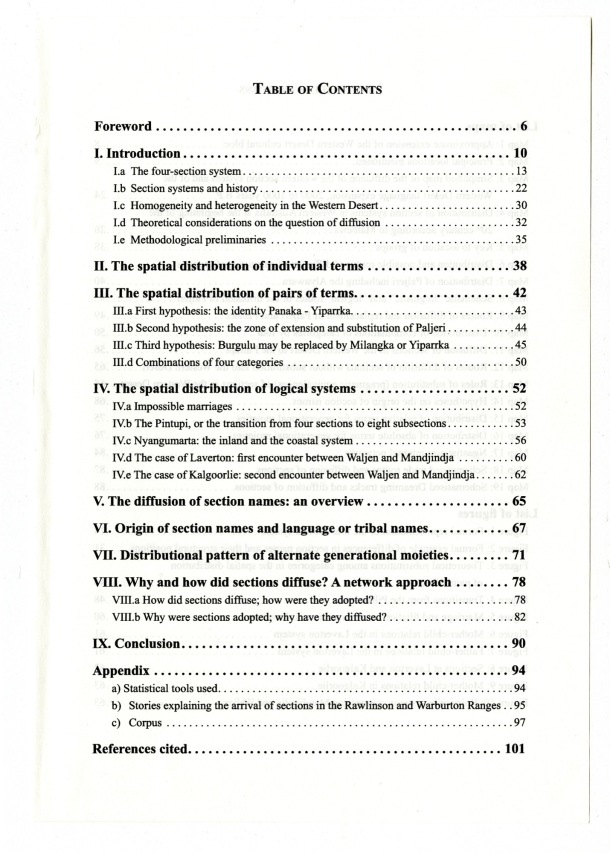|
| 
[Note: thIs transcrIptIon was produced by an automatIc OCR engIne]
TABLE or CONTENTS
Foreword......... . . . . . . . . . . . . . .
I.IntroductIon................................................10
I.a The four-sectIon system . . . . . . . . . . . . . . . . . . . . . . . . . . . . . . . . . . . . . . . . . . . . . . . . 13
I.b SectIon systems and hIstory . . . . . . . . . . . . . . . . . . . . . . . . . . . . . . . . . . . . . . . . . . . . .22
Le HomogeneIty and heterogeneIty In the Western Desert . . . . . . . . . . . . . . . . . . . . . . . . 30
I.d TheoretIcal consIderatIons on the questIon of dIffusIon . . . . . . . . . . . . . . . . . . . . . . .32
I.e MethodologIcal prelImInarIes . . . . . . . . . . . . . . . . . . . . . . . . . . . . . . . . . . . . . . . . . . .35
II. The spatIal dIstrIbutIon ofIndIvIdual terms . . . . . . . . . . . . . . . . . . . . . 38
III.ThespatIaldIstrIbutIonofpaIrsofterms.......................42
III.a FIrst hypothesIs: the IdentIty Panaka - YIparrka . . . . . . . . . . . . . . . . . . . . . . . . . . . . .43
III.b Second hypothesIs: the zone of extensIon and substItutIon of PaljerI . . . . .
IH.c ThIrd hypothesIs: Burgulu may be replaced by MIlangka or YIparrka . . . . . . . . . . .45
IH.d CombInatIons of four categorIes . . . . . . . . . . . . . . . . . . . . . . . . . . . . . . . . . . . . . . . . 50
IV. The spatIal dIstrIbutIon of logIcal systems . . . . . . . . . . . . . . . . . . . . . . 52
Na ImpossIble marrIages . . . . . . . . . . . . . . . . . . . . . . . . . . . . . . . . . . . . . . . . . . . . . . . . .52
IV.b The PIntupI, or the transItIon fl-om four sectIons to eIght subsectIons . . . . . . . . . . . .53
IV.c Nyangumarta: the Inland and the coastal system . . . . . . . . . . . . . . . . . . . . . . . . . . . . 56
IV.d The case of Laverton: fIrst encounter between Waljen and Mandjmdja . . . . . . . . . . 60
We The case of KalgoorlIe: second encounter between Waljen and MandjIndja . . . . . . . 62
V. The dIffusIon of sectIon names: an overvIew . . . . . . . . . . . . . . . . . . . . . 65
VI. OrIgIn of sectIon names and language or trIbal names. . . . . . . . . . . . 67
VH. DIstrIbutIonal pattern of alternate generatIonal moIetIes. . . . . . . . . 71
VIII. Why and how dId sectIons dIffuse? A network approach . . . . . . . . 78
VIII.a How dId sectIons dIflIIse; how were they adopted? . . . . . . . . . . . . . . . . . . . . . . . . 78
VIII.b Why were sectIons adopted; why have they dIflIIsed? . . . . . . . . . . . . . . . . . . . . . . 82
IX.ConclusIon................................................90
a StatIstIcal tools used . . . . . . . . . . . . . . . . . . . . . . . . . . . . . . . . . . . . . . . . . . . . . . . . . . . . 94
b StorIes explaInIng the anIval of sectIons In the RawlInson and Warburton Ranges . . 95
c Corpus . . . . . . . . . . . . . . . . . . . . . . . . . . . . . . . . . . . . . . . . . . . . . . . . . . . . . . . . . . . . .97
ReferencescIted..............................................101
|
| |